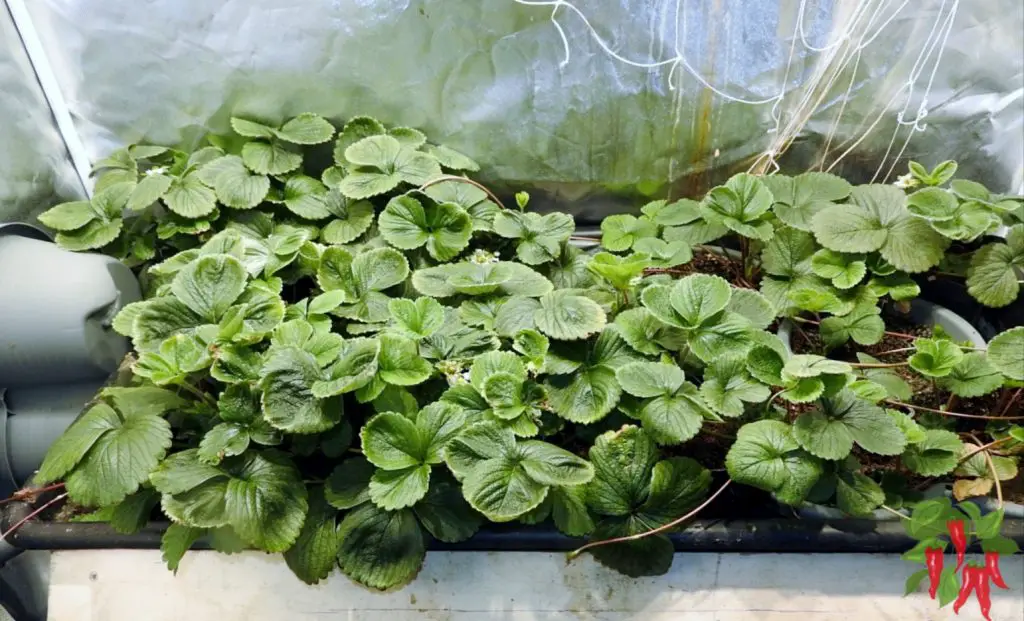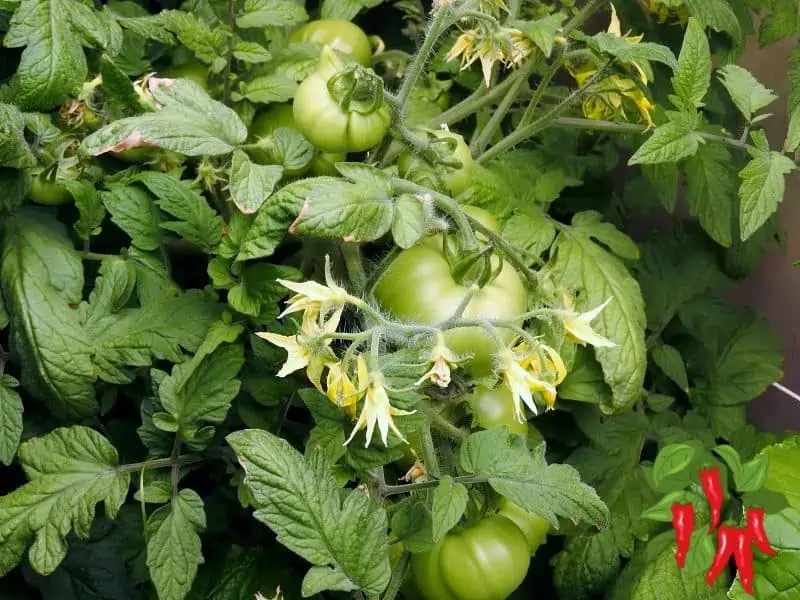This post may contain affiliate links. If you buy something from one of our links we may earn a commission. Thanks

Growing hydroponic strawberries indoors can seem challenging at first, but it’s an exciting and rewarding venture that solves the problem of limited outdoor space.
With the right system and care, you can enjoy fresh, delicious strawberries year-round, free from pests and unpredictable weather.
Let’s dive into the essentials of this innovative gardening method!
Growing Hydroponic Strawberries
Key Takeaways
- Growing hydroponic strawberries indoors allows you to enjoy fresh berries year-round.
- This method uses a soilless system, providing optimal nutrients and controlled conditions for your plants.
- With proper lighting, temperature, and care, hydroponic strawberries can thrive, offering a productive and space-efficient way to garden indoors.
Growing Hydroponic Strawberries Indoors
Seascape Everbearing Strawberry Bare Roots Plants, 25 per Pack
Howdy everyone! Today, we’re diving into the world of growing hydroponic strawberries indoors. I’ll walk you through my personal experience with Seascape strawberries in a flood and drain system, sharing tips and tricks along the way.
Section 1: Basics of Hydroponic Strawberries
Growing hydroponic strawberries indoors is an innovative and efficient way to enjoy fresh, juicy berries all year round.
This method leverages modern gardening techniques to maximize plant health and yield, making it a popular choice for both novice and experienced gardeners.
Do Strawberries Grow Well Hydroponically?
Yes, strawberries grow exceptionally well in hydroponic systems. In fact, they thrive under the controlled conditions provided by hydroponics, which allow for precise management of nutrients, water, and environmental factors.
Why Strawberries Thrive in Hydroponic Systems
Strawberries are well-suited to hydroponic cultivation because they require specific conditions to produce high yields of quality fruit.
Hydroponic systems provide a controlled environment where factors such as nutrient concentration, pH levels, and water availability can be finely tuned to meet the plants’ needs.
This precision ensures that strawberries receive optimal conditions for growth and fruit production.
- Nutrient Control: Hydroponic systems allow for precise control over the nutrient mix, ensuring that strawberries get exactly what they need for robust growth and high yields.
- Water Efficiency: Hydroponics uses water more efficiently than traditional soil-based methods. This is crucial for strawberries, which require consistent moisture levels to thrive.
- Reduced Risk of Disease: Soil-borne diseases are a common problem for strawberries grown in the ground. Hydroponics eliminates this risk by using a soilless medium, significantly reducing the incidence of diseases.
- Space Utilization: Hydroponic setups, especially vertical systems, make the best use of available space, allowing for more plants in a smaller area. This is particularly beneficial for indoor gardening.
Read more:Indoor Apartment Gardening: 15 Point Comprehensive Guide
Benefits Over Traditional Soil Growing
Growing strawberries hydroponically offers several advantages over traditional soil-based methods:
- Pest Control: Without soil, many common pests that affect strawberries are eliminated. This results in healthier plants and reduces the need for pesticides.
- Space Efficiency: Hydroponic systems can be stacked vertically, making them ideal for small spaces. This allows gardeners to grow a significant number of plants in a limited area.
- Faster Growth: Hydroponic strawberries often grow faster than their soil-grown counterparts. The direct delivery of nutrients and water to the roots accelerates growth and fruit production.
- Consistent Yields: The controlled environment of a hydroponic system means that strawberries can be grown year-round, providing a steady supply of fresh berries regardless of the season.
By leveraging these benefits, hydroponic gardening provides an efficient and productive way to grow strawberries indoors, ensuring a plentiful harvest with minimal effort.
Next, we’ll delve into the specifics of setting up your hydroponic system to get started on your own strawberry-growing journey.
Section 2: Setting Up Your Hydroponic System
Choosing the right hydroponic system is key to growing strawberries indoors successfully.
Among the different types out there, the ebb and flow system is particularly effective and versatile for strawberries.
If you’re up for a bit more complexity, top feed drip systems also work great and can provide even better results with a bit of extra effort.
Best Hydroponic System for Strawberries
Ebb and Flow Systems Ebb and flow systems, also known as flood and drain systems, are popular among hydroponic gardeners due to their simplicity and efficiency. Here’s how they work and why they are ideal for growing strawberries:
- How It Works: In an ebb and flow system, plants are placed in a grow tray filled with a growing medium such as coco coir or perlite. The grow tray sits above a reservoir containing the nutrient solution. An electric pump periodically floods the grow tray with the nutrient solution, allowing the plant roots to absorb nutrients and oxygen. After a set period, the solution drains back into the reservoir, ensuring that roots are not waterlogged and have access to air.
- Benefits for Strawberries:
- Efficient Nutrient Delivery: The periodic flooding ensures that strawberry roots receive a consistent supply of nutrients and oxygen, promoting healthy growth and high yields.
- Simple Setup and Maintenance: Ebb and flow systems are relatively easy to set up and maintain, making them suitable for beginners and experienced gardeners alike.
- Space Utilization: These systems can be adapted to various space constraints, including vertical configurations, which are ideal for maximizing limited indoor space.
- Choosing the Right System for Your Space and Budget:
- Small Spaces: For those with limited space, consider a compact ebb and flow system that can fit on a tabletop or a small shelf. These systems are perfect for growing a few strawberry plants without taking up too much room.
- Larger Setups: If you have more space available, larger ebb and flow systems can accommodate more plants and produce higher yields. These systems often come with multiple grow trays and a larger reservoir, suitable for serious home gardeners or small-scale commercial operations.
- Budget Considerations: Ebb and flow systems are available at various price points. Basic DIY setups can be inexpensive, using simple materials like plastic containers and a submersible pump. For those willing to invest more, commercially available kits offer advanced features such as automated timers and more durable construction.
When selecting your system, consider your specific needs, including available space, budget, and the number of plants you wish to grow. Ebb and flow systems provide a flexible and effective solution for cultivating hydroponic strawberries indoors, ensuring a bountiful harvest with minimal hassle.
Converting a Flood and Drain System to Top Feed Drip
If you find that your flood and drain system isn’t meeting your needs, converting it to a top feed drip system can offer more precise nutrient delivery and better plant health. Here’s how to make the switch:
- Assess Your Current Setup: Examine your existing flood and drain system, noting the components you already have, such as the grow tray, reservoir, and pump.
- Gather Necessary Components:
- Drip Emitters: These will deliver nutrient solution directly to the base of each plant.
- Drip Lines: Tubing to connect the emitters to the main nutrient line.
- Main Nutrient Line: Larger tubing to distribute the nutrient solution from the reservoir to the drip lines.
- Manifold: A device to split the main line into multiple drip lines.
- Modify the Pump: Connect the pump in your reservoir to the main nutrient line. Ensure the pump has enough pressure to push the solution through the drip lines to the emitters.
- Install the Drip Lines:
- Run the main nutrient line from the pump to a manifold positioned centrally relative to your grow tray.
- Attach drip lines from the manifold to each plant site, securing drip emitters at the base of each plant.
- Set Up a Timer: Just like in the flood and drain system, use a timer to automate the feeding schedule. However, the intervals will be shorter and more frequent, providing a constant, slow drip of nutrients.
- Test and Adjust: Turn on the system and check each emitter to ensure it’s delivering the right amount of nutrient solution. Adjust the flow rate as necessary to prevent over- or under-watering.
Benefits of Top Feed Drip Systems:
- Precise Nutrient Delivery: Each plant receives a consistent amount of nutrient solution directly to the roots, improving growth and yield.
- Better Aeration: Since the growing medium isn’t saturated, roots get more oxygen, reducing the risk of root rot.
- Flexibility: Top feed systems are easy to expand and modify, making them ideal for scaling up your garden.
Switching to a top feed drip system can optimize your strawberry growth by providing more consistent and controlled nutrient delivery. This method is particularly beneficial if you’ve noticed issues with nutrient deficiencies or uneven growth in your current flood and drain setup.
Next, we’ll discuss planting and growing techniques to ensure your strawberries thrive in their new hydroponic home.
Section 3: Planting and Growing Hydroponic Strawberries
Howdy everyone! Today, we’re diving into the nitty-gritty of how to grow big, juicy hydroponic strawberries. It’s not just about having a hydroponic system—though that’s a great start—but also about selecting the right varieties, planting them correctly, and using the best growing medium. Let’s get into it!
Selecting the Right Strawberry Varieties
Everbearing Ozark Beauty Strawberry Plants 12 Bare Root Plants – TOP Producer
When it comes to growing strawberries hydroponically, not all varieties are created equal. Some strawberry varieties are better suited for hydroponic systems due to their growth habits and fruiting characteristics. Here are a few top picks:
- Seascape: A day-neutral variety that produces fruit throughout the growing season, making it an excellent choice for consistent harvests.
- Alpine: Known for their small but intensely flavorful berries, these are great for hydroponic systems where space might be limited.
- Ozark Beauty: Another everbearing variety, Ozark Beauty is popular for its large, sweet berries and ability to produce multiple harvests in a year.
More Day Neutral Varieties
- Albion: Known for its large, firm berries with excellent flavor. Albion is also resistant to several common strawberry diseases, making it a reliable choice for indoor hydroponics.
- Evie 2: This variety produces sweet, aromatic berries and is known for its high yield and vigorous growth, making it a popular choice among hydroponic gardeners.
- Tribute: Tribute strawberries are known for their firm texture and good flavor. They perform well in various conditions, including hydroponic systems, and offer a steady production of fruit throughout the season.
- Mara des Bois: This variety is celebrated for its exceptional flavor, combining the sweetness of wild strawberries with the robustness of cultivated varieties. It’s an excellent choice for those seeking gourmet-quality berries.
- San Andreas: Similar to Albion, San Andreas offers large, flavorful berries and is known for its high productivity and disease resistance.
By incorporating these day-neutral varieties into your hydroponic setup, you can enjoy a continuous harvest of delicious strawberries throughout the growing season. Happy gardening!
Choosing the right variety is the first step to ensuring a bountiful harvest of big, tasty strawberries.
Preparing Plants and Planting Techniques
Getting your strawberry plants off to a good start is crucial. Here’s how you can prepare your plants for hydroponic success:
- From Seeds: Growing strawberries from seeds can be time-consuming, as they take longer to mature and fruit. If you choose this route, start seeds in a small container filled with a sterile growing medium and keep them under a humidity dome until they sprout.
- From Starts: Most gardeners prefer using young plants or runners. Rinse the soil off the roots of your young plants before placing them in the hydroponic system. This helps prevent any soil-borne diseases from entering your setup.
Whether you start from seeds or young plants, make sure to space them properly in your system to allow for adequate air circulation and light penetration.
Choosing and Preparing the Growing Medium
The growing medium is the foundation of your hydroponic system. It provides support for your plants and helps retain moisture and nutrients.
Here are some of the best options:
- Coco Coir: Made from coconut husks, coco coir is excellent for hydroponics because it retains water well while also providing good aeration to the roots.
- Perlite: Often mixed with other mediums, perlite is a lightweight, volcanic rock that improves drainage and aeration.
- Rockwool: A popular choice in hydroponics, rockwool provides excellent moisture retention and is easy to work with.
Prepare your chosen medium by soaking it in a pH-balanced nutrient solution before planting.
This ensures that your strawberries get off to the best possible start with all the nutrients they need right from the get-go.
By carefully selecting your strawberry varieties, properly preparing and planting your starts, and choosing the right growing medium, you’ll be well on your way to growing big, beautiful hydroponic strawberries.
Up next, we’ll dive into maintaining ideal growing conditions to keep your plants thriving!
Section 4: Maintaining Ideal Growing Conditions
Howdy everyone! If you want your hydroponic strawberries to thrive indoors, getting the growing conditions just right is essential.
Let’s dive into how much space they need, the perfect light and temperature, maintaining proper pH levels, and the importance of ventilation and humidity control.
How Much Space Do Hydroponic Strawberries Need?
Strawberries need enough space to spread their roots and allow for good air circulation.
Each plant should have about 6-8 inches of space around it. This spacing ensures that the plants don’t overcrowd each other, which can lead to poor air circulation and increased risk of diseases.
- Vertical Systems: If you’re using a vertical hydroponic system, make sure each plant pocket has sufficient room. These systems maximize space by growing upwards, perfect for small indoor areas.
- Horizontal Systems: For flat hydroponic setups like ebb and flow, ensure the plants are spaced adequately in the grow tray to prevent overcrowding.
Optimal Light and Temperature Conditions
Strawberries are sun-loving plants, and they need plenty of light to produce those juicy berries.
Aim to provide 8-12 hours of light per day. If natural sunlight is insufficient, especially during winter months, supplement with grow lights.
- Lighting: LED grow lights are a fantastic option as they are energy-efficient and provide the full spectrum of light needed for strawberry growth. Position the lights about 12-18 inches above the plants to ensure even light distribution.
- Temperature: Keep the temperature between 65-80°F. Strawberries prefer a stable temperature, so avoid placing them near drafts or heat sources that can cause fluctuations.
Maintaining Proper pH Levels and Water Quality
The pH level of your nutrient solution plays a critical role in the health of your strawberry plants. Strawberries thrive in a pH range of 5.5-6.5.
- pH Testing: Regularly test your nutrient solution with a pH meter. If the pH is outside the ideal range, adjust it using pH up or pH down solutions.
- Water Quality: Use filtered water to avoid contaminants that can harm your plants. Monitor the electrical conductivity (EC) of the nutrient solution to ensure the right concentration of nutrients. High-quality water and balanced nutrients are essential for robust strawberry growth.
Importance of Ventilation and Humidity Control
Proper ventilation and humidity control are crucial to prevent mold, mildew, and other issues.
- Ventilation: Ensure your grow area has good air circulation. Use fans to keep the air moving, which helps strengthen the plants and prevents stagnant air pockets where mold can thrive.
- Humidity Control: Maintain humidity levels around 50-70%. Too much humidity can lead to mold and mildew, while too little can stress the plants. Use a hygrometer to monitor humidity and adjust as needed with dehumidifiers or humidifiers.
By getting these growing conditions right, you’ll create an ideal environment for your hydroponic strawberries to flourish. Next up, we’ll look into the best practices for planting and nurturing your strawberries to ensure a bountiful harvest!
Section 5: Nutrient Management
Howdy everyone! Now let’s talk about something crucial for your hydroponic strawberries—nutrient management.
Feeding your plants the right nutrients is key to getting those big, juicy berries we all love. Here’s how to ensure your strawberries are well-nourished and thriving.
What Do You Feed Hydroponic Strawberries?
Just like us, strawberries need a balanced diet to grow strong and healthy. In hydroponics, we provide this through a nutrient solution that contains all the essential elements.
Overview of Hydroponic Nutrient Solutions
One of the go-to nutrient solutions for many hydroponic gardeners is Jack’s 3 2 1. This formula is popular because it provides a balanced mix of nutrients tailored for various plants, including strawberries. Here’s a basic rundown of what it includes:
- Macronutrients: Nitrogen (N), Phosphorus (P), and Potassium (K) are the primary nutrients that your strawberries need in large amounts.
- Micronutrients: Essential elements like Calcium (Ca), Magnesium (Mg), and Iron (Fe) are also crucial, even though they are needed in smaller quantities.
Using a well-balanced nutrient solution ensures your strawberries get the right nutrients for optimal growth and fruit production.
Adjusting Nutrient Levels and Monitoring Electrical Conductivity (EC)
Maintaining the right nutrient levels in your hydroponic system is essential. This is where monitoring the electrical conductivity (EC) comes into play.
- Electrical Conductivity (EC): EC measures the concentration of nutrients in your solution. It’s important to keep this within the optimal range for strawberries, typically between 1.5 to 2.5 mS/cm(750 to 1250 ppms on 500 scale). Too high or too low, and your plants might suffer.
- Regular Monitoring: Use an EC meter to regularly check the nutrient concentration. If the EC is too high, dilute the solution with water. If it’s too low, add more nutrient solution.
- Here is the U.S. PPMS are often used instead of EC but most meters will give both readings.
Keeping a close eye on your EC levels helps ensure your strawberries are getting just the right amount of nutrients without any risk of nutrient burn or deficiencies.
Addressing Nutrient Deficiencies and Troubleshooting Common Issues
Even with the best care, sometimes things can go awry. Here are some common nutrient deficiencies and how to address them:
- Nitrogen Deficiency: Yellowing leaves are often a sign of nitrogen deficiency. If you notice this, consider adjusting your nutrient mix to increase nitrogen levels.
- Calcium Deficiency: If you see distorted or misshapen new growth, your plants might be lacking calcium. Adding a calcium supplement can help correct this.
- Magnesium Deficiency: Yellowing between the leaf veins while the veins remain green is a sign of magnesium deficiency. Epsom salt (magnesium sulfate) can be added to correct this issue.
Troubleshooting these common issues involves careful observation and timely adjustments to your nutrient solution. Regularly inspecting your plants and making the necessary changes will keep your strawberries healthy and productive.
By managing your nutrients effectively, you’ll set the stage for a bountiful harvest of delicious, hydroponic strawberries. Happy gardening, and keep it green!
Section 6: Pollination and Pruning
Today, we’re tackling the essential tasks of pollination and pruning in your hydroponic strawberry garden.
These steps are vital to ensure your strawberries not only grow but thrive, producing abundant, delicious fruit.
How Do You Pollinate Strawberries in Hydroponics?
In a hydroponic setup, especially indoors, natural pollinators like bees are often absent. This means we have to step in and give Mother Nature a hand with some manual pollination.
Importance of Manual Pollination Strawberry flowers are self-pollinating, but to boost fruit production, manual pollination can make a big difference. Here’s how you can do it:
- Using a Q-Tip or Brush: Gently brush a Q-tip or a small, soft brush across the center of each flower. This helps transfer pollen from one part of the flower to another, mimicking the action of bees.
- Consistency: Make sure to do this regularly, especially during the flowering stage. It ensures that every flower gets the chance to produce a fruit.
Manual pollination is straightforward but crucial for maximizing your strawberry yield in an indoor hydroponic system.
Pruning Techniques to Remove Runners and Promote Fruit Production
Pruning is another critical task that helps your strawberry plants focus their energy on producing fruit rather than spreading out runners.
- Removing Runners: Runners are long stems that develop new baby plants. While they can be useful for propagation, they divert energy away from fruit production. Regularly trim these runners off to keep your plants focused on producing berries.
- Trimming Dead Leaves: Remove any yellowing or dead leaves. This not only improves airflow around your plants but also helps them focus their energy on healthy growth and fruiting.
By keeping your plants pruned, you encourage them to put more energy into producing bigger and better strawberries.
Section 7: Harvesting and Yield
Howdy everyone! Let’s dive into one of the most rewarding parts of growing hydroponic strawberries: harvesting and understanding the expected yield.
Knowing what to expect in terms of production and how to harvest properly can help you maximize your hydroponic garden’s potential.
How Many Strawberries Will One Plant Yield?
When it comes to yield, several factors come into play, including the variety of strawberry, growing conditions, and how well you maintain your hydroponic system. On average, a well-cared-for hydroponic strawberry plant can produce around 1 to 1.5 pounds of fruit per year.
- Variety Matters: Some varieties, like Seascape or Albion, are known for their high yields and continuous production throughout the growing season.
- Growth Conditions: Optimal light, temperature, and nutrient management play a crucial role in maximizing yield. Ensuring that your plants are in their ideal growing conditions will boost their productivity.
Expected Yield and Frequency of Harvests
Hydroponic strawberries typically produce fruit continuously, especially if you’re growing day-neutral varieties. Here’s what you can expect:
- Continuous Production: Unlike traditional seasonal strawberries, hydroponic setups allow for nearly year-round production. Plants can flower and fruit multiple times a year under the right conditions.
- Harvest Frequency: You can expect to harvest strawberries every few weeks once the plants start producing. Regular harvesting is key to encouraging continuous fruiting.
Best Practices for Harvesting Ripe Strawberries to Ensure Continued Production
To keep your strawberry plants producing, it’s essential to harvest the fruit correctly and at the right time.
- Timing: Pick strawberries when they are fully red and have a glossy appearance. This ensures they are ripe and have the best flavor.
- Harvesting Technique: Use clean scissors or pruners to cut the berries from the plant, leaving a small portion of the stem attached. This helps prevent damage to the plant and reduces the risk of disease.
- Regular Harvesting: Check your plants frequently and harvest ripe berries promptly. Leaving overripe berries on the plant can lead to rot and attract pests, which can hinder future fruit production.
By following these best practices, you’ll not only enjoy delicious, fresh strawberries but also keep your plants healthy and productive for many months to come.
Section 8: Troubleshooting and Maintenance
Howdy everyone! Even with the best setup and care, issues can arise in your hydroponic strawberry garden. Let’s tackle some common problems and solutions to keep your plants thriving, and discuss regular maintenance routines to ensure your system runs smoothly.
Why Are My Strawberries Flowering But No Fruit?
Seeing your strawberry plants flowering without producing fruit can be frustrating. Here are some common reasons why this might happen and how to fix them:
1. Pollination Issues
- Manual Pollination: In an indoor hydroponic setup, natural pollinators are absent. Ensure you’re manually pollinating the flowers using a soft brush or Q-tip. This helps transfer pollen and promotes fruit set.
- Air Circulation: Good air circulation helps with pollen movement. Use fans to improve airflow around your plants.
2. Nutrient Imbalances
- Proper Nutrition: Ensure your nutrient solution is balanced. Lack of essential nutrients, especially potassium and phosphorus, can prevent fruit development. Regularly check and adjust your nutrient solution to meet your plants’ needs.
- pH Levels: Maintain the pH between 5.5 and 6.5. An incorrect pH can lock out essential nutrients, hindering fruit production.
3. Environmental Factors
- Light and Temperature: Ensure your plants are getting 8-12 hours of light per day and the temperature is between 65-80°F. Inadequate light or extreme temperatures can stress the plants and inhibit fruiting.
Regular Maintenance Routines to Keep Your Hydroponic System Running Smoothly
Keeping your hydroponic system in top shape requires regular maintenance. Here’s a routine to follow:
1. Daily Checks
- Nutrient Solution: Check the level and quality of your nutrient solution daily. Ensure the reservoir is filled and the solution is well-mixed.
- pH and EC Levels: Use a pH meter and EC meter to check the levels daily. Adjust as needed to keep within the optimal ranges for strawberries.
2. Weekly Maintenance
- Cleanliness: Wipe down the grow tray and reservoir to prevent algae and pathogen buildup. Ensure all components are clean and free from debris.
- Inspect Plants: Check for any signs of pests or diseases. Remove any affected leaves or plants immediately to prevent spread.
3. Monthly Checks
- System Inspection: Thoroughly inspect your entire system, including pumps, tubing, and lights. Look for wear and tear, and replace any faulty components.
- Nutrient Solution Refresh: Completely drain and replace the nutrient solution monthly. This helps prevent nutrient imbalances and ensures fresh nutrients for your plants.
By staying on top of these maintenance routines and troubleshooting common issues, you can ensure your hydroponic strawberries stay healthy and productive. Happy gardening, and keep it green!
By incorporating these solutions and maintenance tips, you’ll be well-equipped to handle any challenges that come your way in your hydroponic strawberry journey.
Section 9: Overwintering and Long-Term Care
As we transition through the seasons, it’s important to know how to care for your hydroponic strawberries to ensure they thrive year-round.
Let’s dive into how to overwinter your strawberries and provide long-term care to keep those delicious berries coming.
How Do You Overwinter Hydroponic Strawberries?
Overwintering your hydroponic strawberries means keeping them healthy and productive even through the colder months.
Here are some techniques to maintain your plants through winter and ensure year-round production:
1. Adjusting Light and Temperature
- Light: As daylight hours decrease, it’s crucial to supplement natural light with grow lights. Ensure your strawberries receive 8-12 hours of light daily. LED grow lights are a great choice because they are energy-efficient and provide the necessary spectrum for plant growth.
- Temperature: Maintain a stable temperature between 65-75°F. Strawberries can handle cooler temperatures but maintaining warmth will keep them actively growing and fruiting. Avoid placing your setup near drafts or windows that can lead to temperature fluctuations.
2. Reducing Watering Frequency
- Water Needs: In winter, plants generally use less water due to slower growth rates. Adjust the watering schedule of your hydroponic system to prevent overwatering and root rot. Monitor the moisture levels in your growing medium and adjust accordingly.
3. Pruning and Maintenance
- Pruning: Trim any dead or yellowing leaves and remove runners to keep your plants tidy and focused on producing fruit. Regular pruning helps maintain healthy airflow and reduces the risk of disease.
- System Cleanliness: Keep your hydroponic system clean to prevent the buildup of algae and pathogens. Regularly clean the reservoir, grow trays, and any other components to maintain a healthy environment for your plants.
4. Nutrient Management
- Nutrient Solution: Continue using a balanced nutrient solution like Jax 321, but be mindful of nutrient levels. With reduced growth, you may need to adjust the concentration slightly to match the plants’ needs.
- Monitoring: Regularly check the pH and electrical conductivity (EC) of your nutrient solution. Keeping these levels stable is crucial for plant health, especially when growth slows in cooler temperatures.
Techniques for Year-Round Production
To keep your strawberries producing all year, consider these long-term care strategies:
1. Consistent Light and Temperature
- Maintain consistent light and temperature conditions to prevent your plants from entering dormancy. This consistency encourages continuous flowering and fruiting.
2. Staggered Planting
- Plant new strawberry plants at different times to ensure a staggered production cycle. This way, as some plants slow down, others are just beginning to produce, ensuring a steady supply of strawberries.
3. Rotating Crops
- Rotate your strawberry plants with other hydroponic-friendly crops. This helps prevent nutrient depletion in your growing medium and reduces the risk of disease buildup.
By following these overwintering techniques and long-term care strategies, you can enjoy fresh, home-grown strawberries all year long. Next, we’ll wrap things up with a conclusion that highlights the key takeaways from our journey into growing hydroponic strawberries indoors. Happy gardening, and keep it green!
Section 10: Safety and Consumption
Howdy everyone! Let’s talk about one of the best parts of growing your own strawberries: eating them! Ensuring that your hydroponic strawberries are safe to eat and properly prepared is crucial for enjoying the fruits of your labor. Here’s how to do it.
Are Hydroponic Strawberries Safe to Eat?
Absolutely! Hydroponic strawberries are not only safe to eat but also often cleaner and healthier than those grown in soil. Here’s why:
- Controlled Environment: Hydroponic systems allow you to control every aspect of the growing environment, from nutrients to water quality. This reduces the risk of contamination from soil-borne diseases and pests.
- Reduced Pesticide Use: Because hydroponic systems are less prone to pests, there’s usually less need for chemical pesticides. This means your strawberries can be grown more organically and are often safer to consume right off the plant.
By maintaining a clean and controlled hydroponic system, you ensure that your strawberries are free from harmful chemicals and contaminants.
Ensuring Safe and Clean Produce from Your Hydroponic Garden
To ensure your hydroponic strawberries are as safe and clean as possible, follow these best practices:
- Regular Maintenance: Keep your hydroponic system clean. Regularly check and clean the reservoir, grow trays, and other components to prevent algae and bacteria buildup.
- Water Quality: Use filtered or purified water in your hydroponic system to avoid introducing contaminants. Regularly monitor and adjust the pH and nutrient levels to keep the environment optimal for plant health.
- Healthy Practices: Always handle your plants with clean hands and tools to prevent the introduction of pathogens.
Do I Need to Wash Hydroponic Strawberries?
While hydroponic strawberries are often cleaner than their soil-grown counterparts, it’s still a good idea to wash them before eating. Here’s how to prepare your strawberries for consumption:
- Rinse Thoroughly: Give your strawberries a good rinse under cool running water. This helps remove any dust, insects, or residues that might have settled on them.
- Dry Properly: After rinsing, gently pat the strawberries dry with a clean towel or let them air dry. This prevents any excess moisture from spoiling the fruit.
- Inspect and Store: Check for any damaged or overripe berries and use them first. Store the clean strawberries in a breathable container in the refrigerator to keep them fresh.
By following these simple steps, you can enjoy your hydroponic strawberries safely and ensure they taste as fresh and delicious as possible.
Next, we’ll wrap things up with a conclusion that highlights the key takeaways from our guide to growing hydroponic strawberries indoors. Happy gardening, and keep it green!
Growing Hydroponic Strawberries Indoors Conclusion
Howdy everyone! We’ve covered a lot of ground in our journey to growing hydroponic strawberries indoors.
From selecting the right varieties and setting up your system to mastering nutrient management and ensuring your strawberries are safe to eat, you’re now equipped with the knowledge to grow delicious strawberries all year round.
Let’s recap the benefits and joys of this innovative gardening method.
Benefits and Joys of Growing Hydroponic Strawberries Indoors
Growing hydroponic strawberries indoors offers a plethora of benefits. Not only does it allow you to enjoy fresh, juicy strawberries regardless of the season, but it also provides a cleaner, more controlled environment for your plants. Here’s a quick rundown of why hydroponic strawberries are a great choice:
- Controlled Environment: Manage every aspect of your plants’ needs—from light and temperature to nutrients and water quality—ensuring healthier and more productive plants.
- Space Efficiency: Vertical systems and compact setups make hydroponics ideal for small spaces.
- Reduced Pests and Diseases: Without soil, many common pests and diseases are less of a problem, resulting in cleaner and safer produce.
- Year-Round Production: Enjoy fresh strawberries throughout the year by maintaining optimal conditions.
The ability to control these factors means less stress and more enjoyment from your gardening experience.
Encouragement to Try Hydroponic Gardening
If you haven’t tried hydroponic gardening yet, now is the perfect time to start. The rewards are plentiful, and the process is both fun and fulfilling. Imagine picking fresh strawberries right from your living room or kitchen! Here’s why you should give it a shot:
- Fresh Produce: Hydroponics provides a constant supply of fresh, home-grown strawberries, bursting with flavor and nutrition.
- Educational and Fun: It’s a great way to learn about plant biology and modern gardening techniques. Plus, it’s a fantastic hobby for both kids and adults.
- Health Benefits: Growing your own food ensures you know exactly what goes into your produce—no pesticides, just pure goodness.
With the tips and techniques we’ve discussed, you can set up your own hydroponic system and enjoy the satisfaction of growing your own food.
Key Takeaways
- Controlled Environment: Hydroponics allows you to control the growing conditions, leading to healthier plants and higher yields.
- Space Efficiency: Vertical systems and compact setups make hydroponics ideal for small spaces.
- Year-Round Production: Enjoy fresh strawberries throughout the year by maintaining optimal light, temperature, and nutrient conditions.
- Reduced Pests and Diseases: Without soil, many common pests and diseases are less of a problem, resulting in cleaner and safer produce.
- Nutrient Management: Regular monitoring and adjustment of nutrient solutions ensure your plants get exactly what they need.
By embracing hydroponic gardening, you can transform your indoor space into a productive garden, providing fresh strawberries and other produce year-round.
Final Thoughts
That’s all for now, folks! I hope you feel inspired and ready to dive into the world of hydroponic gardening.
Remember, the journey is just as rewarding as the harvest. So, keep it green, enjoy your gardening journey, and happy growing! See y’all later, bye-bye!
Growing Hydroponic Strawberries Indoors FAQs
Howdy everyone! Here are some frequently asked questions about growing hydroponic strawberries indoors. These answers should help you get started and address any lingering queries you might have. Let’s dive in!
Do strawberries grow well hydroponically?
Yes, strawberries grow exceptionally well hydroponically. Hydroponic systems provide a controlled environment where you can precisely manage light, nutrients, and water, leading to healthier plants and higher yields compared to traditional soil gardening.
How many times can you harvest hydroponic strawberries?
Hydroponic strawberries, especially day-neutral varieties, can be harvested multiple times throughout the year. These plants continuously produce fruit under optimal conditions, allowing for several harvests each year.
Are hydroponic strawberries safe to eat?
Absolutely! Hydroponic strawberries are often safer to eat than soil-grown ones because they are grown in a controlled environment with fewer pests and diseases, reducing the need for pesticides. Just ensure proper maintenance of your system and clean water.
How much space do hydroponic strawberries need?
Each hydroponic strawberry plant requires about 6-8 inches of space around it to ensure good air circulation and prevent overcrowding. This spacing helps the plants to grow healthily and produce better yields.
How do you pollinate strawberries in hydroponics?
In an indoor hydroponic setup, manual pollination is necessary. You can use a soft brush or Q-tip to gently transfer pollen from one flower to another, mimicking the natural pollination process.
Are strawberries better in soil or hydroponics?
Both methods have their advantages. Hydroponic strawberries often grow faster and produce higher yields due to the controlled environment and efficient nutrient delivery. Soil-grown strawberries might have a different flavor profile and benefit from natural soil ecosystems.
Do I need to wash hydroponic strawberries?
Yes, it’s still a good idea to wash hydroponic strawberries before eating them to remove any dust, insects, or residues. Rinse them under cool running water and dry them gently.
How many strawberries will one plant yield?
A well-maintained hydroponic strawberry plant can yield approximately 1 to 1.5 pounds of strawberries per year, though this can vary based on the variety and growing conditions.
How do you overwinter hydroponic strawberries?
To overwinter hydroponic strawberries, maintain stable light and temperature conditions, reduce watering frequency, and keep the plants in a well-ventilated area. This helps them stay healthy and continue producing fruit through the winter months.
What do you feed hydroponic strawberries?
Hydroponic strawberries thrive on a balanced nutrient solution like Jack’s 3 2 1, which provides essential macronutrients and micronutrients. Regularly monitor and adjust the nutrient levels to match the plants’ needs.
Will hydroponic strawberries produce year-round?
Yes, with proper light, temperature, and nutrient management, hydroponic strawberries can produce fruit year-round, especially day-neutral varieties that are not dependent on specific daylight lengths.
Do you need 2 strawberry plants to pollinate?
No, strawberries are self-pollinating, meaning each flower contains both male and female parts. However, manual pollination can improve fruit set and yield.
Do self-pollinating strawberries need bees?
While self-pollinating strawberries do not need bees, having pollinators can help improve the pollination process. In indoor hydroponic setups, manual pollination is usually necessary.
How do you yield more strawberries?
To increase your strawberry yield, ensure optimal light, temperature, and nutrient conditions. Regularly prune your plants to remove runners and dead leaves, and ensure proper pollination techniques are used.
Do hydroponic strawberries need to be pollinated?
Yes, even though strawberries are self-pollinating, manual pollination is beneficial in an indoor hydroponic setup to ensure a good fruit set and higher yields.
Should I pinch off strawberry flowers?
Pinching off the first few flowers of a young strawberry plant can help the plant focus its energy on establishing strong roots and foliage, leading to better yields in the long run.
What is the best pollinator for strawberries?
In an indoor hydroponic setup, the best pollinator is you! Use a soft brush or Q-tip to manually pollinate the flowers, ensuring each one gets pollinated for maximum fruit production.
Why are my strawberries flowering but no fruit?
If your strawberries are flowering but not producing fruit, it could be due to insufficient pollination, nutrient imbalances, or environmental stress. Ensure you’re manually pollinating, providing balanced nutrients, and maintaining optimal growing conditions.
Do strawberry plants like to be crowded?
No, strawberry plants do not like to be crowded. Proper spacing is essential to ensure good air circulation and reduce the risk of disease, leading to healthier plants and better yields.
I hope these FAQs help you on your hydroponic gardening journey. Happy gardening, and keep it green!
Visit my Amazon Influencer Page for videos and gardening products Grow Your Own Garden










